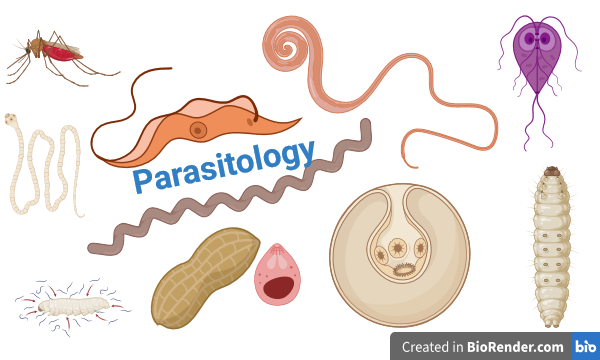What is Parasitology?
- Parasitology is the area of biology concerned with the phenomenon of dependence of one living organism on another.
- Medical parasitology deals with the parasites that infect man, the diseases they produce, the response generated by him against them and various methods of diagnosis and prevention.
- The scientific study of parasites and parasitism is known as parasitology. It is an area of biology concerned with the interactions between parasites and their hosts. Parasitologists research parasites in a variety of ways, including their morphology, life cycles, ecology, and impact on their hosts. Parasites are organisms that live on or within other species known as hosts, gaining nutrition and other benefits at the host’s expense.

Importance of Parasitology
Understanding Parasitic Diseases:
- Parasitology is essential to understanding the biology, life cycle, and pathogenesis of parasites that cause diseases in humans, animals, and plants. This knowledge is important to develop effective strategies for prevention, control and treatment.
Impact on public health:
- Parasitic infections can have a significant impact on public health, especially in developing countries. Parasitology contributes to the identification of parasites, assessment of disease burden, and the development of public health interventions to control and manage parasitic infections.
Vector Borne Diseases:
- Many parasites are spread through vectors such as mosquitoes, ticks and fleas. Parasitology helps to study the life cycle of these parasites, understand the dynamics of their transmission, and develop methods to control the vectors, thereby preventing the spread of diseases such as malaria, dengue, and Lyme disease.
Drug development:
- Parasitologists play an important role in the development of drugs to treat parasitic infections. Understanding the unique biology of parasites allows researchers to identify targets for drug development, leading to the creation of effective and specific antiparasitic drugs.
Zoonotic Infection:
- Parasitology helps to identify and understand zoonotic parasites – those that can be transmitted between animals and humans. This knowledge is important for preventing and controlling diseases that can cross species barriers, reducing the risk of outbreaks and epidemics.
What is Parasite?
- A living organism that receives nourishment and shelter from another organism where it lives is called a parasites.
- A parasite does not necessarily cause disease.
- Simply parasitism is living in association with the host.
- The parasite derives all benefits from the association and the host may either not be harmed or may suffer the consequences of these associations.
- The parasite gets all the benefits from the association and the host does not suffer any harm either and may have to suffer the consequences of this association, which is a parasitic disease.
- A parasite is an organism that is entirely dependent on another organism, referred to as its host, for all or part of its life cycle and metabolic requirements.
Types of Parasite
The parasite is of two types:
1. Microparasites: small, unicellular and multiply within its vertebrate host, often inside cells. Protozoa are microparasites.
2. Macroparasites: large, multicellular and have no direct reproduction within its vertebrate host. This category includes helminths.
(1). Parasites can be divided according to their habitat into:-
A. Ectoparasite: Ectoparasite is a type of parasite that lives on the outside surface of its host organism rather than inside its body. These parasites have evolved to take advantage of their host’s resources, often by consuming blood, tissue or other body fluids. Many different hosts, including mammals, birds, and even reptiles, are susceptible to ectoparasites. As such Like mites, lice etc. Infection by these parasites is known as infection.
B. Endoparasite: Endoparasites are a type of parasitic organisms that live inside the bodies of their host organisms. Unlike ectoparasites, which live on the external surface of their host, endoparasites have adopted an internal lifestyle, often within the host’s tissues, organs or body cavities such as worms, protozoa, etc. Invasion by endoparasite is known as infection. endoparasite can be further subdivided into the following types:
(2). Parasites can be divided according to the nature of living into:-
A. Obligatory parasite: Parasite that cannot survive outside of a host e.g.,Toxoplasma gondi.
B. Facultative parasite: Lives a parasitic life when the opportunity arises.
C. Aberrant parasites: Organisms that attack a host where they cannot live or develop further e.g.,Toxocara canis in man.
D. Accidental parasite Organisms: that attack an unusual host e.g.,Echinococcus granulosus in man.
E. Free-living: The nonparasitic stages existence which are lived independently of a host, e.g., hookworms have active free-living stages in the soil.
(3). Parasites can be divided according to the length of time they spend with the:-
A. Temporary parasite: Visits its host for a short period. They are parasites that visit their host only when feeding and then leave after they get the food like mosquitoes sucking human blood which is called a Temporary parasite.
B. Stationary parasites: parasites that live a specific period of their life in or on their host are called Stationary parasites.
C. periodic parasites: live for some time with their host and then leave their host to live free which is called periodic parasites.
D. permanent parasites: parasites that spend all their life with their host.
(4). Parasites can be divided according to the number of hosts required:-
A. Monoxenous parasite: which has one host.
B. Heteroxenous parasite: which has more than one host.
What is Hosts?
An organism that harbours the parasite and provides nourishment and shelter to the latter.
Types of hosts: There are five type of host as follow:
- Definitive host: Either harbours the adult stage of the parasite. Or where the parasite uses an external method of reproduction. In most human parasitic infections, humans are the definitive host. In malaria and hydatid disease, humans act as intermediate hosts.
- Intermediate host: It harbours the larval stages of the parasite. In some cases, larval developments are completed in two different intermediate hosts. These are referred to as first and second intermediate hosts respectively.
3. Reservoir host: It is a host that harbours the parasite and serves as an important source of infection to other susceptible hosts. Epidemiologically, reservoir hosts are important in the control of parasitic disease.
4. Paratenic or Carrier host: A host where the parasite remains viable without further development.
5. Compromised host: A compromised host is a host in which normal defence mechanisms are impaired such as in AIDS, absent as in congenital deficiencies, or bypassed (for example, penetration of the skin barrier), this host is susceptible to a variety of normal as well as Are extremely susceptible to opportunistic pathogens.
References
- Introduction to Parasitology: National Library of Medicine.
- Parasitology an overview: ScienceDirect.
- Parasitology, Definition and Examples: Learn Biology Online.
- About Parasites: Centers for Disease Control And Prevention.
- https://www.cartercenter.org/resources/pdfs/health/ephti/library/lecture_notes/health_science_students/medicalparasitology.pdf


3 thoughts on “Introduction to Parasitology”